Fritz Hansen's Egg table features a gentle, curved design that is familiar to Arne Jacobsen's work. The Danish designer originally designed the three-legged table to be paired with his Ant chair, but the table's minimalist elegance makes it versatile enough to pair with various seating options, whether in a home dining room or a restaurant. The combination of a walnut-veneered top and chrome legs remains as modern and stylish now as it was when first introduced in 1952.
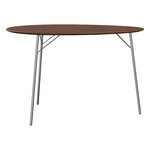
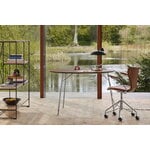

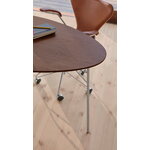
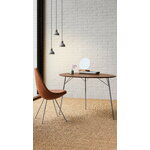
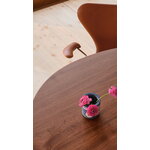
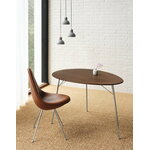
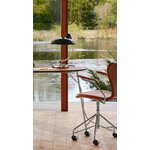
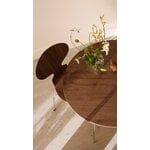
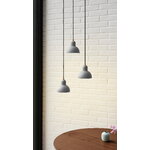
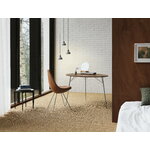
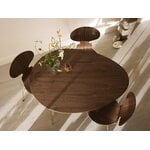
Egg table, 115 x 84 cm, chrome - walnut
Fritz Hansen
Description
Fritz Hansen's Egg table features a gentle, curved design that is familiar to Arne Jacobsen's work. The Danish designer originally designed the three-legged table to be paired with his Ant chair, but the table's minimalist elegance makes it versatile enough to pair with various seating options, whether in a home dining room or a restaurant. The combination of a walnut-veneered top and chrome legs remains as modern and stylish now as it was when first introduced in 1952.
Product details (8)
- Colour
- Walnut, chrome
- Length
- 115 cm
- Width
- 84 cm
- Height
- 72 cm
- Table top material
- Clear lacquered walnut veneer
- Base material
- Chromed steel. Mounted with glides.
- Weight
- 15 kg
- Notes
- Comes flat-packed.
- Product ID
Designer
Arne Jacobsen (1902-1971) is the most celebrated post-war Danish designer and architect. He graduated from the School of Applied Arts in 1924 and from the Royal Danish Academy of Fine Arts, where he studied architecture, in 1927. Arne Jacobsen worked actively both as an architect and as a designer and received many prestigious awards for his designs, including C. F. Hansen Medal and the Grand Prix of Milan XI Triennale.
Read moreReviews (0)
Sustainability
The Product Sustainability Framework, our criteria of sustainable design, helps you find the most sustainable products in our selection. Read below which sustainability criteria this product has met.
Working conditions & labour 9/9
-
Equal opportunities for all employees
-
Commitment to UN Global Compact, fair compensation for all employees
-
Corporate responsibility requirements defined and communicated for suppliers
-
Systematic work for improved inclusion and well-being in the workplace
-
Transparent supply chain
-
Suppliers' compliance to a code of conduct ensured
-
Direct suppliers audited and certified
-
Compliance to the UN Guiding Principles on Business and Human Rights ensured in the supply chain
-
Support for community involvement in the supply chain
Eco-friendly production 5/9
-
Fair and resource-wise water-use in production
-
No incineration or landfilling of returned items
-
No use of endangered species as materials
-
No direct environmental emissions or waste (excl. GHGs) from production
-
Material-efficient and ecological packaging
Climate impact 5/8
-
Company's direct greenhouse gas emissions identified and commitment to reduction
-
Product's carbon impact identified and commitment to reduction
-
Guidance on energy- and eco-efficient use of the product
-
Contribution to climate initiatives beyond the brand’s direct operations
-
Carbon footprint of the product calculated and goals set to reduce it
Sustainable materials 4/6
-
Sustainable and long-lasting material choices
-
No harmful or hazardous substances
-
Responsible raw material sourcing and production
-
Ecological materials: natural, biodegradable, recyclable or recycled contents
Circular design 4/5
-
High aesthetic quality promoting long-term use of the product
-
Technically durable product design and material choices
-
Design for enduring life-long quality
-
Design and support for product maintenance, repair and upgradability















